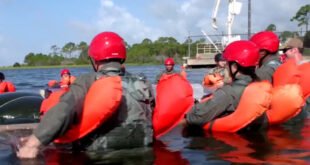Watch as a US pilot flies a plane super low over a Silent Drill Platoon! Experience the thrill of aviation in this American Airlines trip report.
Since the beginning of flying, people have formed air forces, and the need to demonstrate their abilities as a team has grown. The Three Musketeers flight demonstration team of the U.S. Army Air Corps is where the U.S. Navy Blue Angels, the second-oldest military flight display squadron, derives indirectly from.
When the Blue Angels originally organized in 1946, they had an initial formation of four Grumman F6F-5 Hellcat fighters. Their distinctive blue and gold paint scheme easily distinguishes them from other aerial demonstration teams.
The colors stand for the finest qualities of the US Navy. The F-A-18 Hornets frequently visit the paint shop to have their paint touched up to guarantee that they always look their best. It takes a lot of work to get the Blue Angels ready to fly the planes and provide equipment-equipped support staff for airshows.
The Blue Angel pilots are in charge of flying their high-performance aircraft, which are often F-A-18 Hornets, to each airshow location. This demonstrates not only their skill as a pilot but also, if relevant, the aircraft’s maintenance requirements. For the unit, the well-known C-130J Hercules, also referred to as Fat Albert, provides logistical support planes.
It is in charge of carrying about 80 support personnel, maintenance supplies, and replacement parts aboard. Fat Albert was the C-130 Hercules before it became the C-130J. The Blue Angels settle in before the show flight is ready to go before they arrive at the location.
Mainly, maintainers, support staff members check their planes to make sure the pilots are taking off in optimal operating condition. Crew chiefs oversee maintenance teams and are the individuals who certify an aircraft as being ready for flight. The pilot will fire up their aircraft and take off shortly after getting the maintenance report and a final salute from their crew commanders.
The U.S. Marine Corps’ Silent Drill Platoon frequently participates in the performance. Their precise drill skills, which are topped off by flybys from Fat Albert, delight the crowd. Spectators at some airshows can witness the Silent Drill Platoon and Fat Albert perform precise, gravity-defying feats.
Fat Albert shows off the C-130’s operational capabilities with low-pass, high-speed, and short-field assault maneuvers. Meanwhile, in rifle drills, the Silent Drill Platoon demonstrates to a captivated audience the ceremonial perfection, discipline, and spirit de corps of the Corps with perfect coordination and unwavering discipline. Fat Albert’s airshow repertoire, which showcases the tactical skills of the C-130, captivates audiences.
The performance’s opening short-field takeoff showcases the aircraft’s exceptional thrust-to-weight ratio. The aircraft next demonstrates its quick climb ability, which is essential for combat insertions, by performing a range of maneuvers, including steep angle ascents. Low-altitude passes and abrupt, flat turns follow, demonstrating agility beyond its stature.
The combat unload technique, which showcases how the aircraft can rapidly eject cargo while its engines are idle, stands out as a highlight. In order to simulate landing on sparse runways and showcase the aircraft’s skill in short-field landing with the least amount of runway length required, the presentation ends with a max-effort landing. The Thunderbirds are the air display team of the United States Air Force.
The Thunderbirds are incredibly talented and well-behaved airshow performers. With these high-performance aircraft, a complete demonstration flight takes around 37 minutes, and it takes all of their concentration to make sure everything goes according to plan. The flight leader continually shouts out a cadence over their radios so that they can fly in perfect formation and perform incredible aerial maneuvers.
The sound you hear is actually a rhythmic method of giving commands to the planes, so they all stay in sync and are aware of what is going on. Five other aircraft stay in sync when the flight leader reports even the slightest variation in speed or g-force. The four lead aircraft, known as Thunderbirds 1 through 4, perform the majority of the show’s maneuvers and nearly always stay in a diamond formation.
The novice pilots, aircraft numbers 5 and 6, join that formation. The Delta Roll, in which all six Thunderbirds fly in formation and perform a slow, continuous roll that requires exact synchronization, is one of their trickiest maneuvers. The support staff is crucial, even in the lead-up to the flight demonstration.
A meticulously practiced pre-flight ballet is performed by crew leaders and maintenance staff. As they move among the F-16 Fighting Falcons, their blue uniforms stand out, signifying a disciplined pattern honed through innumerable repetitions. This coordinated procedure starts with a comprehensive external examination of every jet, utilizing a methodical touch-and-go approach to find defects.
Maintaining the operational integrity of these high-performance jets requires meticulous attention to detail, which is demonstrated by the comprehensive evaluation of the aircraft’s systems carried out simultaneously by maintenance professionals. With intense focus, pilots approach the red, white, and blue jets. When a check is successful, the crew chiefs mark it with crisp salutes, which the pilots return to show that man and machine are in sync.
The Thunderbirds’ famous airborne prowess is introduced with these incredibly precise ground maneuvers. The flawless ground performance becomes aerial artistry when the motors roar to life. When it comes to accomplishing military goals in a world where airpower is essential, pilot proficiency can make all the difference.
When pilots and high-performance aircraft come together, they can accomplish great things. The goal of airshows is to raise military support among the next generation of fighter pilots while showcasing the capabilities of the aircraft and pilots. This concludes the video.I hope it was enjoyable for you. To ensure that you don’t miss any of our upcoming content, please subscribe to this channel. Until we meet again!
 DailyDiscovery
DailyDiscovery





